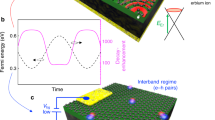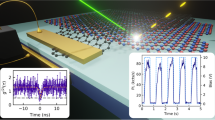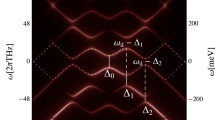Abstract
Controlling the energy flow processes and the associated energy relaxation rates of a light emitter is of fundamental interest and has many applications in the fields of quantum optics, photovoltaics, photodetection, biosensing and light emission. Advanced dielectric, semiconductor and metallic systems have been developed to tailor the interaction between an emitter and its environment. However, active control of the energy flow from an emitter into optical, electronic or plasmonic excitations has remained challenging. Here, we demonstrate in situ electrical control of the relaxation pathways of excited erbium ions, which emit light at the technologically relevant telecommunication wavelength of 1.5 μm. By placing the erbium at a few nanometres distance from graphene, we modify the relaxation rate by more than a factor of three, and control whether the emitter decays into electron–hole pairs, emitted photons or graphene near-infrared plasmons, confined to <15 nm from the graphene sheet. These capabilities to dictate optical energy transfer processes through electrical control of the local density of optical states constitute a new paradigm for active (quantum) photonics and can be applied using any combination of light emitters and two-dimensional materials.
This is a preview of subscription content, access via your institution
Access options
Subscribe to this journal
Receive 12 print issues and online access
$209.00 per year
only $17.42 per issue
Buy this article
- Purchase on Springer Link
- Instant access to full article PDF
Prices may be subject to local taxes which are calculated during checkout




Similar content being viewed by others
References
Yablonovitch, E. Inhibited spontaneous emission in solid-state physics and electronics. Phys. Rev. Lett. 58, 2059–2062 (1987).
Joulain, K., Carminati, R., Mulet, J-P. & Greffet, J-J. Definition and measurement of the local density of electromagnetic states close to an interface. Phys. Rev. B. 68, 245405 (2003).
Novotny, L. & Hecht, B. Principles of Nano-Optics (Cambridge Univ. Press, 2006).
Gérard, J. M. et al. Enhanced spontaneous emission by quantum boxes in a monolithic optical microcavity. Phys. Rev. Lett. 81, 1110–1113 (1998).
Raimond, J. M., Brune, M. & Haroche, S. Colloquium: Manipulating quantum entanglement with atoms and photons in a cavity. Rev. Mod. Phys. 73, 565–582 (2001).
Englund, D. et al. Controlling cavity reflectivity with a single quantum dot. Nature 450, 857–861 (2007).
Hennessy, K. et al. Quantum nature of a strongly coupled single quantum dot–cavity system. Nature 445, 896–899 (2007).
Lodahl, P. et al. Controlling the dynamics of spontaneous emission from quantum dots by photonic crystals. Nature 430, 654–657 (2004).
Englund, D. et al. Controlling the spontaneous emission rate of single quantum dots in a two-dimensional photonic crystal. Phys. Rev. Lett. 95, 013904 (2005).
Novotny, L. & van Hulst, N. F. Antennas for light. Nature Photon. 5, 83–90 (2011).
Coffa, A., Franzò, & Priolo, F. High efficiency and fast modulation of Er-doped light emitting Si diodes. Appl. Phys. Lett. 69, 2077–2079 (1996).
Laucht, A. et al. Electrical control of spontaneous emission and strong coupling for a single quantum dot. New. J. Phys. 11, 123034 (2009).
Polman, A. Erbium implanted thin film photonic materials. J. Appl. Phys. 82, 1–39 (1997).
Snoeks, E., Lagendijk, A. & Polman, A. Measuring and modifying the spontaneous emission rate of erbium near an interface. Phys. Rev. Lett. 74, 2459–2462 (1995).
Grätzel, M. Photoelectrochemical cells. Nature 414, 338–344 (2001).
Atwater, H. A. & Polman, A. Plasmonics for improved photovoltaic devices. Nature Mater. 9, 205–213 (2010).
Anker, J. N. et al. Biosensing with plasmonic nanosensors. Nature Mater. 7, 442–453 (2008).
Achermann, M. et al. Energy-transfer pumping of semiconductor nanocrystals using an epitaxial quantum well. Nature 429, 642–646 (2004).
Vakil, A. & Engheta, N. Transformation optics using graphene. Science 332, 1291–1294 (2011).
Swathi, R. & Sebastian, K. J. Resonance energy transfer from a dye molecule to graphene. J. Chem. Phys. 129, 054703 (2008).
Gomez-Santos, G. & Stauber, T. Fluorescence quenching in graphene: A fundamental ruler and evidence for transverse plasmons. Phys. Rev. B 84, 165438 (2011).
Velizhanin, K. A. & Shahbazyan, T. V. Long-range plasmon-assisted energy transfer over doped graphene. Phys. Rev. B 86, 245432 (2012).
Polini, M. et al. Plasmons and the spectral function of graphene. Phys. Rev. B 77, 081411(R) (2008).
Jablan, M., Buljan, H. & Soljaćić, M. Plasmonics in graphene at infrared frequencies. Phys. Rev. B 80, 245435 (2009).
Grigorenko, A. N., Polini, M. & Novoselov, K. S. Graphene plasmonics. Nature Photon. 6, 749–758 (2012).
Chen, J. et al. Optical nano-imaging of gate-tunable graphene plasmons. Nature 487, 77–81 (2012).
Fei, Z. et al. Gate-tuning of graphene plasmons revealed by infrared nano-imaging. Nature 487, 82–85 (2012).
Yan, H. et al. Damping pathways of mid-infrared plasmons in graphene nanostructures. Nature Photon. 7, 394–399 (2013).
Yan, H. et al. Tunable infrared plasmonic devices using graphene/insulator stacks. Nature Nanotech. 7, 330–334 (2012).
Ju, L. et al. Graphene plasmonics for tunable terahertz metamaterials. Nature Nanotech. 6, 630–634 (2011).
Fang, Z. et al. Gated tunability and hybridization of localized plasmons in nanostructured graphene. ACS Nano 7, 2388–2395 (2013).
Brar, V. W., Jang, M. S., Sherrott, M., Lopez, J. J. & Atwater, H. A. Highly confined tunable mid-infrared plasmonics in graphene nanoresonators. Nano Lett. 13, 2541–2547 (2013).
Nikitin, A. Yu., Guinea, F., García-Vidal, F. J. & Martin-Moreno, L. Fields radiated by a nanoemitter in a graphene sheet. Phys. Rev. B 84, 195446 (2011).
Koppens, F. H. L., Chang, D. E. & García de Abajo, F. J. Graphene plasmonics: A platform for strong light–matter interactions. Nano Lett. 11, 3370–3377 (2011).
Das, A. et al. Monitoring dopants by Raman scattering in an electrochemically top-gated graphene transistor. Nature Nanotech. 3, 210–215 (2008).
Treossi, E. et al. High-contrast visualization of graphene oxide on dye-sensitized glass, quartz, and silicon by fluorescence quenching. J. Am. Chem. Soc. 131, 15576–15577 (2009).
Chen, Z., Berciaud, S., Nuckolls, C., Heinz, T. F. & Brus, L. E. Energy transfer from individual semiconductor nanocrystals to graphene. ACS Nano 4, 2964–2968 (2010).
Gaudreau, L. et al. Universal distance-scaling of nonradiative energy transfer to graphene. Nano Lett. 13, 2030–2035 (2013).
Blanco, L. A. & García de Abajo, F. J. Spontaneous light emission in complex nanostructures. Phys. Rev. B 69, 205414 (2004).
Li, D. et al. Quantifying and controlling the magnetic dipole contribution to 1.5 μm light emission in erbium-doped yttrium oxide. Phys. Rev. B 89, 161409(R) (2014).
Li, Z. Q. et al. Dirac charge dynamics in graphene by infrared spectroscopy. Nature Phys. 4, 532–535 (2008).
Wunsch, B., Stauber, T., Sols, F. & Guinea, F. Dynamical polarization of graphene at finite doping. New J. Phys. 8, 318 (2006).
Hwang, E. H. & Das Sarma, S. Dielectric function, screening, and plasmons in two-dimensional graphene. Phys. Rev. B 75, 205418 (2007).
Brenneis, A. et al. Ultrafast electronic readout of diamond nitrogen-vacancy centres coupled to graphene. Preprint at http://arXiv.org/abs/1408.1864 (2014)
Yin, C. et al. Optical addressing of an individual erbium ion in silicon. Nature 497, 91–95 (2013).
Acknowledgements
K.J.T. thanks NWO for a Rubicon fellowship. F.H.L.K. acknowledges support by the Fundacio Cellex Barcelona, the ERC Career integration grant 294056 (GRANOP), the ERC starting grant 307806 (CarbonLight) and support by the E.C. under Graphene Flagship (contract no. CNECT-ICT-604391). F.J.G.d.A. acknowledges support from the Graphene Flagship CNECT-ICT-604391 and FP7-ICT-2013-613024-GRASP. The work at MIT has been supported by AFOSR grant number FA9550-11-1-0225, a Packard Fellowship, and the MISTI-Spain program. This work made use of the Materials Research Science and Engineering Center Shared Experimental Facilities supported by the National Science Foundation (NSF; award no. DMR-0819762) and of Harvard’s Center for Nanoscale Systems, supported by the NSF (grant ECS-0335765). P.G. thanks ANR project RAMACO (No. 12-BS08-0015-01).
Author information
Authors and Affiliations
Contributions
F.H.L.K., P.J-H., F.J.G.d.A., H.d.R. and K.J.T. conceived the experiment. K.J.T., L.O., M.B., S.C. and L.G. carried out the experiments. K.J.T., L.O., F.J.G.d.A., P.J-H. and F.H.L.K. performed the data analysis. A.F., B.K., T.C., A.C., A.P., A.Z. and P.G. provided materials. G.N., M.B., L.O., S.N. and Q.M. fabricated the samples. F.J.G.d.A. developed the theoretical models. K.J.T., F.H.L.K., P.J-H. and F.J.G.d.A. wrote the manuscript with the participation of all authors.
Corresponding author
Ethics declarations
Competing interests
The authors declare no competing financial interests.
Supplementary information
Supplementary Information
Supplementary Information (PDF 625 kb)
Rights and permissions
About this article
Cite this article
Tielrooij, K., Orona, L., Ferrier, A. et al. Electrical control of optical emitter relaxation pathways enabled by graphene. Nature Phys 11, 281–287 (2015). https://doi.org/10.1038/nphys3204
Received:
Accepted:
Published:
Issue Date:
DOI: https://doi.org/10.1038/nphys3204
This article is cited by
-
Light–matter interactions with photonic quasiparticles
Nature Reviews Physics (2020)
-
Fast electrical modulation of strong near-field interactions between erbium emitters and graphene
Nature Communications (2020)
-
High-contrast switching and high-efficiency extracting for spontaneous emission based on tunable gap surface plasmon
Scientific Reports (2018)
-
Waveguide-coupled nanopillar metal-cavity light-emitting diodes on silicon
Nature Communications (2017)
-
Dynamically controlled Purcell enhancement of visible spontaneous emission in a gated plasmonic heterostructure
Nature Communications (2017)



